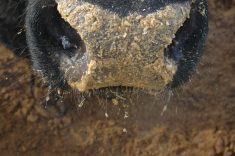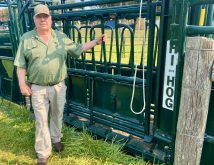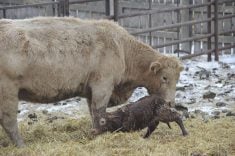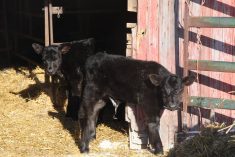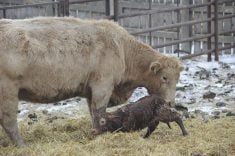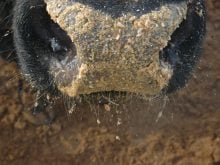There are two types of prolapse in cows — vaginal prolapses before calving and uterine prolapses after calving — and they have very different causes.
The former type is more common and usually not life-threatening but the latter is always an emergency.
Dr. Andy Acton of Deep South Animal Clinic in Ogema, Sask., says a vaginal prolapse involves the walls of the birth canal pushing out, rather than the calf bed itself. For the veterinarian first called, photos of the situation can help determine whether a producer can deal with the problem themselves or whether an on-farm visit or bringing the animal to the clinic is the best option.
Read Also

Pork sector targets sustainability
Manitoba Pork has a new guiding document, entitled Building a Sustainable Future, outlining its sustainability goals for the years to come.
“In terms of scheduling, and how much of an emergency it is, a cow with a vaginal prolapse can be brought to us,” says Acton, but a uterine prolapse is generally dealt with on the farm as an emergency.
Vaginal prolapse results from a cow’s structural weakness that allows part of the vagina to prolapse during late pregnancy. Most cases occur a few weeks before calving, when there’s a lot of pressure in the abdomen from increased size of the uterus. Ligaments in the pelvic region also relax at this stage.
When the cow is lying down, especially if her hind end is downhill, pressure may cause vaginal tissue to prolapse. Mild prolapses, characterized by a pink bulge about the size of an orange or grapefruit, will usually go back in when the cow gets up.
But if the cow starts to prolapse each time it lies down, or strains while lying, tissues may be forced out farther. Then the prolapse may become nearly basketball size and cannot go back in. Sometimes a mild prolapse will stimulate the cow to strain, resulting in a large mass of vaginal tissue bulging outward and becoming damaged and dirty.
The vaginal prolapse is usually a smooth, pink ball. Less common is a cervical prolapse, in which the cervix comes out first.
“This looks a bit different,” says Acton. “The swollen ridges of the cervix are visible. It’s the same size as a typical vaginal prolapse, but not as smooth and round.”
This type of prolapse can be washed off and pushed back inside the cow. Then sutures are placed across the vulva and left until the cow calves.
“Is the cow a week ahead of calving, or two months? Will the stockman be able to monitor her and know when she starts to calve? There are certain kinds of suturing we can do, intended to expand when the cow calves, so it won’t tear out or prevent the calf from coming out, but ideally someone should be there when she calves to cut those sutures,” says Acton.
“If she can’t be closely monitored, we don’t want a torn-up cow and a dead calf, so we use a tension-release suture. It consists of two heavy sutures that are held together with something that will release when the cow calves.
“It’s not foolproof. If there’s a lot of pressure just from the prolapse, it might come out too soon, but may enable the cow to calve,” he says. “If we do a secure suture, we tell producers to keep a close eye on the cow. When they are sure she’s within a week or less of calving, we induce labour,” and the sutures can then be opened.
Some cows in late pregnancy tend to prolapse every time they lie down. As they get older it may get worse and at some point the prolapse stays out and needs attention.
“We recommend culling cows that had a vaginal prolapse because they tend to do it every year,” says Acton.
“In rare cases, if a cow consumed feed containing mould with estrogen-like compounds, this could make her prone to prolapse, and it’s not a genetic fault. A cow might also be straining too much because of a uterine or urinary tract infection.
“Even if it’s not genetic, she will probably repeat the prolapse next year. Try to manage her through calving, let her raise the calf, and then sell her,” says Acton.
Uterine prolapses are less common and are usually due to a difficult calving. It’s generally a one-time event for that cow and it can be kept in the breeding herd if it rebreeds on schedule.
The prolapse can occur immediately after calving or shortly after, while the cervix is still dilated. If the cow keeps straining because of continued contractions, the uterus is pushed out.
To lessen the likelihood of uterine prolapse, get the cow up as soon as possible after pulling a calf. This will usually help the uterus drop back in the abdominal cavity.
If there is a prolapse, early intervention is vital because the uterus is still clean and easier to put back inside. It is also easier on the cow if it can be replaced quickly before any bruising or damage.
If one of the uterine arteries ruptures, the animal will quickly bleed to death. In cold weather, the large mass of tissue becomes chilled.
“When you find a prolapsed cow, handle her quietly but move her to a facility where you can keep her until the veterinarian arrives so she can’t run off and damage the uterus. It should be a clean place, and out of the wind if weather is cold,” says Acton.
Few producers try to replace the uterus themselves and Acton has seen cases where fatal injuries were incurred by producers before the veterinarian arrived.
Replacing a uterine prolapse takes experience and skill and is challenging without the benefit of epidural injection to diminish straining.
“If she is strong and standing, we can replace it while she’s standing. If she’s weak, we’d rather have her down,” Acton says.
“We get her into a frog-leg position. At that angle she isn’t as able to keep pushing the uterus out as you work on it, with gravity in your favour.
“We give her the proper anesthetic so she is less able to strain. Then it’s a matter of patience to replace the uterus, using enough force but not too much force.”
After the uterus is replaced, the veterinarian sutures across the vulva to keep the cow from pushing it out again. The producer can take the sutures out a week later.
“We generally give the cow oxytocin to stimulate the uterus to contract and start shrinking down,” Acton says.
“Occasionally we see a herd with multiple cows prolapsing, but this is rare. Those cows may have a calcium deficiency. Calcium is important for muscle contraction.
“If calcium level is borderline and the cow is tired from a hard birth, the uterine muscle won’t contract as it should, and more easily turns inside out,” he says.





